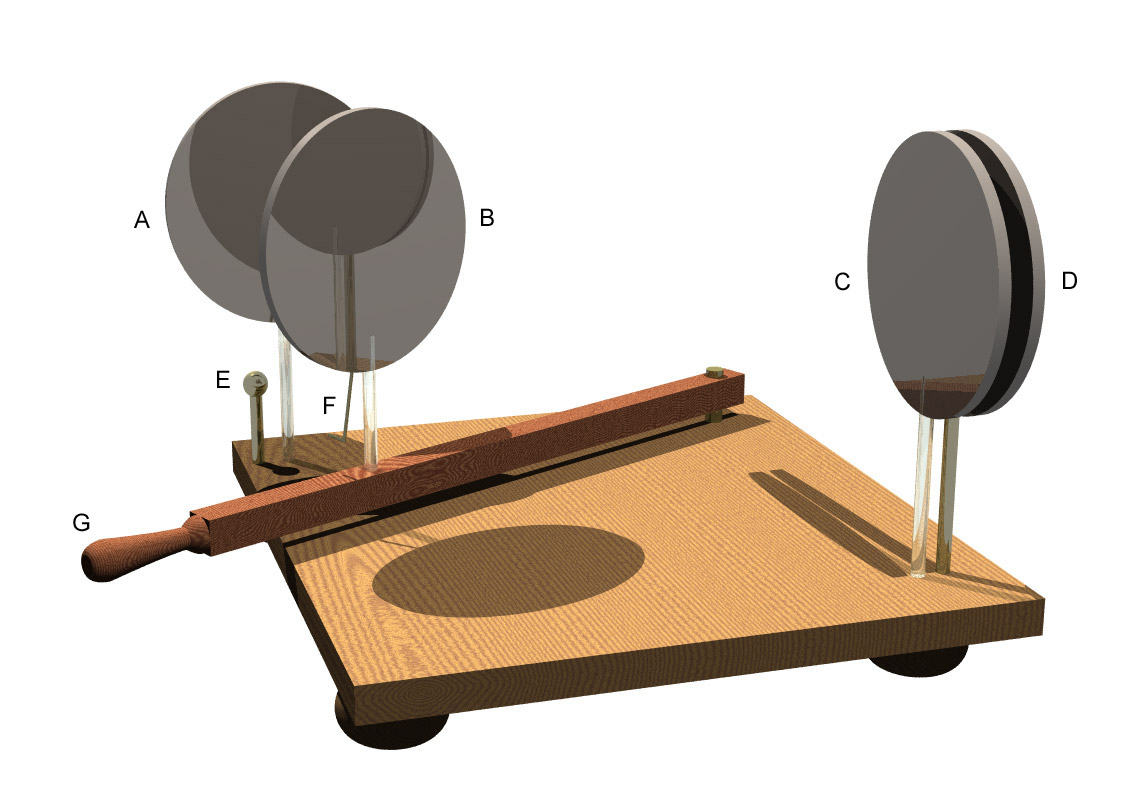Cavallo Multiplier on:
[Wikipedia]
[Google]
[Amazon]
 Cavallo's multiplier was an early electrostatic influence machine, invented in 1795 by the Anglo-Italian
Cavallo's multiplier was an early electrostatic influence machine, invented in 1795 by the Anglo-Italian
Video of reproduction Wilson's machine
Historical scientific instruments
 Cavallo's multiplier was an early electrostatic influence machine, invented in 1795 by the Anglo-Italian
Cavallo's multiplier was an early electrostatic influence machine, invented in 1795 by the Anglo-Italian natural philosopher
Natural philosophy or philosophy of nature (from Latin ''philosophia naturalis'') is the philosophical study of physics, that is, nature and the physical universe. It was dominant before the development of modern science.
From the ancient wor ...
Tiberius Cavallo
Tiberius Cavallo (also Tiberio) (30 March 1749, Naples, Italy21 December 1809, London, England) was an Italian physicist and natural philosopher.
His interests included electricity, the development of scientific instruments, the nature of " ...
. Its purpose was to multiply, or amplify, a small electric charge
Electric charge is the physical property of matter that causes charged matter to experience a force when placed in an electromagnetic field. Electric charge can be ''positive'' or ''negative'' (commonly carried by protons and electrons respecti ...
to a level where it was detectable by the insensitive electroscope
The electroscope is an early scientific instrument used to detect the presence of electric charge on a body. It detects charge by the movement of a test object due to the Coulomb electrostatic force on it. The amount of charge on an object is ...
s of the day. Repeated operation of the device could produce voltages high enough to generate sparks.
Description
Cavallo described his machine in his 1795 ''Treatise on Electricity''. He had examined Bennet's charge doubler of 1787 and found it wanting in several regards, notably in its inconsistent operation and tendency to retain the charge from an earlier experiment. Cavallo resolved to build a better device. His machine consisted of four metal plates supported on a wooden board by posts, of which three were insulating and one conducting. The charge to be multiplied was applied to the first of these (plate ''A''), which stood on an insulating post. A moveable insulated metal plate (''B'') was brought close to ''A'' (though not permitted to touch it), and thengrounded
Grounding or grounded may refer to:
Science and philosophy
* Grounding (metaphysics), a topic of wide philosophical interest
* Grounding (psychology), a strategy for coping with stress or other negative emotions
* Grounding in communication, th ...
. The charge on ''A'' caused charge separation on ''B'' due to electrostatic induction
Electrostatic induction, also known as "electrostatic influence" or simply "influence" in Europe and Latin America, is a redistribution of electric charge in an object that is caused by the influence of nearby charges. In the presence of a charg ...
. Plate ''B'' was then moved away, breaking its earth connection. Since ''B'' was insulated, it acquired and retained a small charge opposite in sign to the charge on ''A''. Plate ''B'' was transferred by means of an insulating rod to be brought into electrical contact with the third metal plate ''C'' which was insulated. Since both ''B'' and ''C'' were conducting, ''B'' would transfer a portion of its charge to ''C''. To maximise the transferred charge, ''C'' was placed in close proximity to a final metal plate ''D'', which was earthed.
The experimenter would move Plate ''B'' repeatedly back and forth, placing it near to ''A'' and earthed at one end of its motion, and then into contact with ''C'' at the other. With each cycle, charge was drawn from the Earth and added to ''C''. After a suitable number of cycles, the grounded plate ''D'' would be removed, and the electrostatic potential
Electrostatics is a branch of physics that studies electric charges at rest (static electricity).
Since classical times, it has been known that some materials, such as amber, attract lightweight particles after rubbing. The Greek word for ambe ...
on ''C'' would rise to approximately the potential of ''A'' multiplied by the number of operations.
Cavallo termed his device a multiplier, though 'addition' was perhaps a more accurate description of its operation, as the charge on ''C'' was accumulated by successive additions.
Wilson's machine
Wilson's machine, described by its inventor in ''Nicholson's Journal
''A Journal of Natural Philosophy, Chemistry, and the Arts'', generally known as ''Nicholson's Journal'', was the first monthly scientific journal in Great Britain. William Nicholson began it in 1797 and was the editor until it merged with anoth ...
'' in August 1804, was a development on this concept which simultaneously operated two Cavallo's multipliers by means of a pair of reciprocating levers. One side would accumulate the charge of the other, and since the two accumulating plates were connected together by means of a wire, Wilson's machine was a true multiplier, rather than an addition machine. The charge would thus accumulate more rapidly than Cavallo's multiplier and the machine could generate high voltages in a short period of time. It moreover was self-exciting, needing no initial charge to operate, as the small initial charge acquired from contact electrification
Contact electrification is a phrase that describes a phenomenon whereby surfaces become electrically charged, via a number of possible mechanisms, when two or more objects come within close proximity of one another. When two objects are "touched" ...
was enough to start the accumulation process.
References
{{ReflistExternal links
Video of reproduction Wilson's machine
Historical scientific instruments